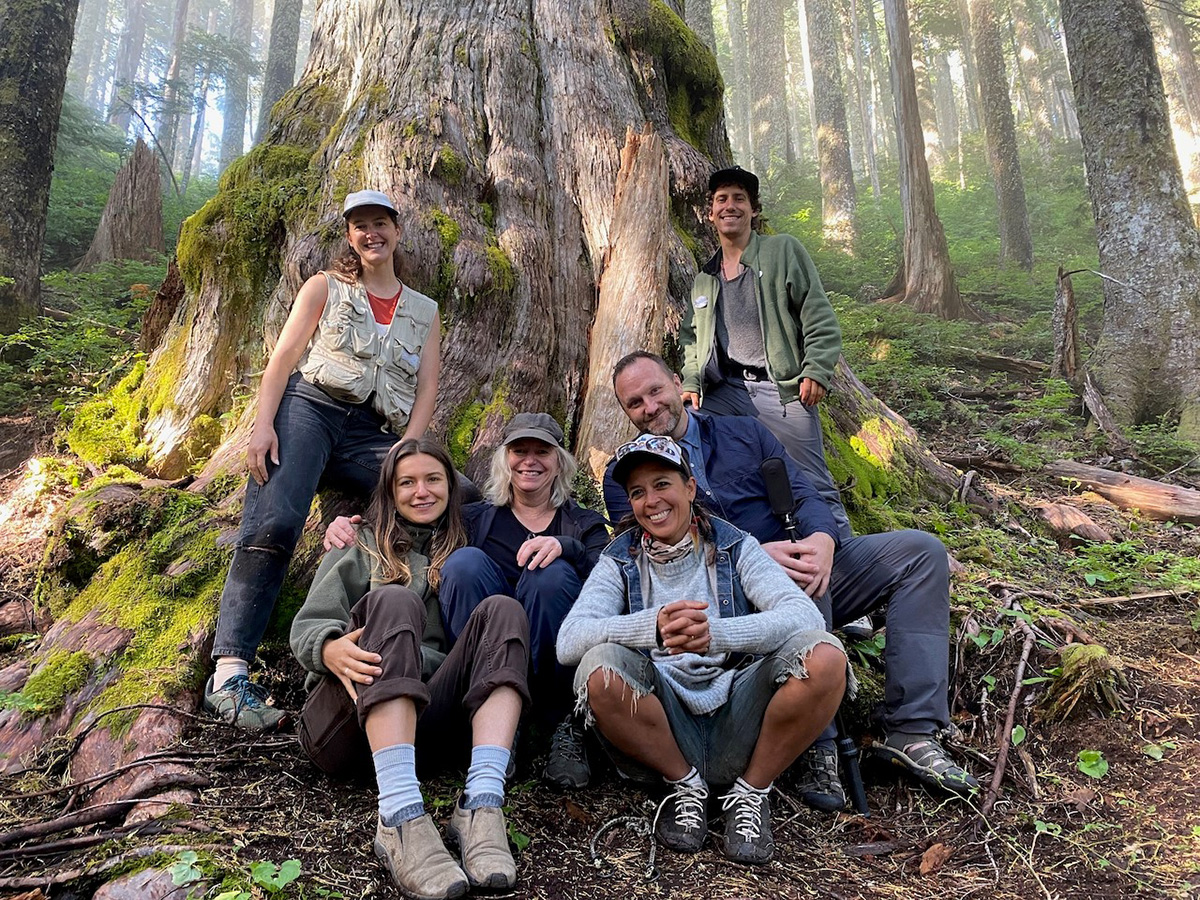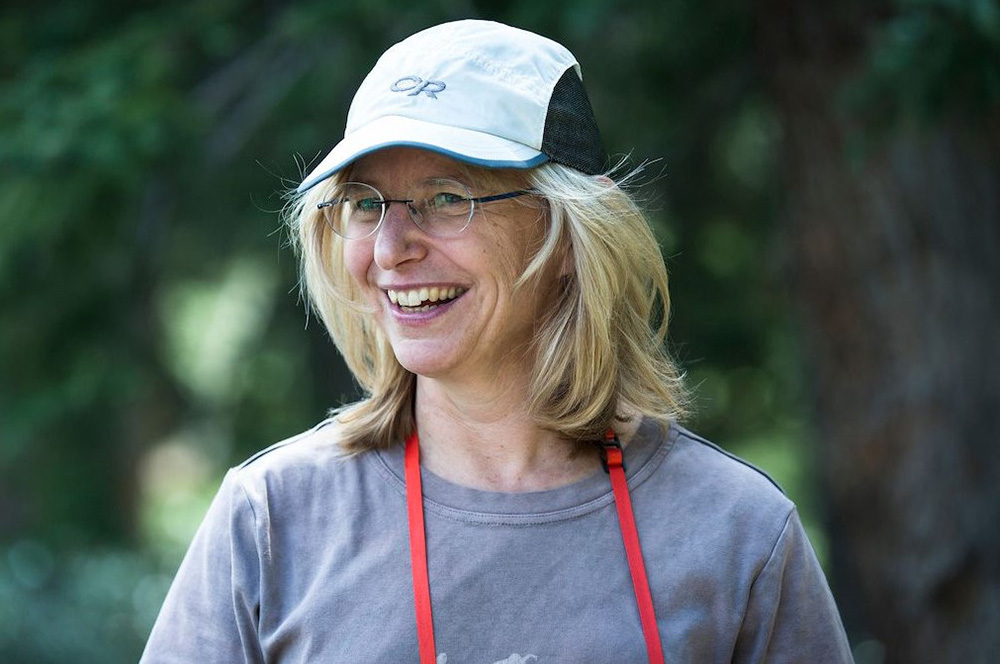Suzanne Simard grew up in a province home to ancient forests. Now 60, she laments that B.C. has become a province of clearcuts, with only remnants of old growth left.
On Sunday, she flew by helicopter from Port Renfrew on southern Vancouver Island to the disputed Fairy Creek area, diverting north to pass over Caycuse, an old-growth watershed recently clear cut after forest protectors were evicted by the RCMP.
"The clear cutting is disgraceful," she told The Tyee Monday as she sat by the windows of a friend's waterfront home in Saanich. "It looks like a war zone." Whole hillsides have been scalped and once majestic ancient trees reduced to gaping stumps.
"You see clearcuts everywhere in B.C., on the Island, Prince George, Nelson. The soils are so shallow, it will take geological time to recover."
It’s a message she would seek to deliver to Premier John Horgan later that evening, as people rallying to save the province’s last remaining swaths of old-growth temperate rainforest hung on her words in front of the legislature.
A forest ecologist at UBC and the author of the best-selling book Finding the Mother Tree, Simard speaks with the authority of a scientist who has conducted rigorous research showing that trees communicate, nurture each other and form networks that can stretch for miles under the forest floor.
Her book suggests that trees are endlessly sharing and co-operating, and portrays elements of her personal life — trial and triumph, disease, sudden death, love and loss. The story will be adapted to the screen in an upcoming film starring Hollywood actress Amy Adams.
But Simard also speaks with the passion of a mother of two young adult daughters who is concerned about the inability of our leaders to take the bold steps to avoid the climate catastrophe, previewed this summer in B.C. with scorching temperatures and raging wildfires.
As we sit and talk, I glimpse the sweeping view through the waterfront windows and catch paddle boarders drifting by, offshore islets, the Olympic Mountains on the horizon. But Simard seems to gaze longingly at the sky, transparently clear on this brilliant summer day without a trace of fog or mist.
At her home in Nelson, she explains, the air is so laden with smoke from surrounding wildfires that in the midst of forest ecology and advocacy on her two-day trip to the Island, she planned an escape from the Kootenays, scouting out a place to live in Victoria for her family.
It’s hardly lost on Simard that these wildfires are connected to the campaign to save old-growth forests, which are much more effective at resisting forest fires than second growth plantations.

In person, Simard comes across as she does in her five-million times viewed TED Talk "How Trees Talk to Each Other" — enthusiastic, personable, gently persuasive.
After the Caycuse flyover, the helicopter veered south to the headwaters of Fairy Creek, landing on a logging road. Two forest protectors met Simard, her daughter Nava and a few media reps and guided them to an ancient forest on a steep hillside.
There they came face to trunk with a huge yellow cedar named Titania (after a Shakespearean fairy queen), which dominated the surrounding area.
Titania is "very special, a matriarch, a connector," Simard attested — two to three metres in girth, up to 70 metres tall, a root system of similar size and perhaps as old as 2,000 years.
She said the road slated to be built in the original logging plan would have cut right through this huge Mother Tree. "The forest would have been clear cut, devastating the watershed, causing slides, silting the creek."
But logging here was deferred for two years in June by the B.C. government, at the request of the local Pacheedaht, Ditidaht and Huu-ay-aht First Nations, who are developing their own stewardship plans.
Simard says we've run out of time for temporary deferrals and promises, and a provincewide moratorium on logging ancient forests is now an imperative.
Old-growth rainforests consist of 1,300 tonnes of carbon per hectare, compared with 1,100 tonnes in tropical rainforests, and 70 per cent of that carbon is lost into the atmosphere when the forest is clear cut. Deforestation, she says, accounts for 20 per cent of our carbon emissions.
"We're blowing a hole in our ability to meet our climate targets."
But she's confident there's a way forward if we have the courage to work together and change how we treat the forests. "I study ecosystems, they're wired to heal, they're meant to grow and regenerate. We humans also have systems, we can see connections, we can solve problems."
Later on Monday, Simard spoke at a rally at the legislature marking the one-year milestone of the Fairy Creek blockades. The RCMP chose that time to launch their biggest raid yet on three protest camps, arresting 20 people, and at least another 30 as of Wednesday afternoon, protest leaders say.
"It's absolutely shameful how the people at Fairy Creek are treated," she told the crowd. "Our young people and our elders are putting their freaking lives on the line just to save our forests and Horgan and the police forces made this a criminal activity. This is wrong."
She called on Premier Horgan to attend a proposed summit of scientists and First Nations leaders "to work out a better plan for our forests. What you're doing right now is not working."
The new plan must include restoration of damaged forests, a major reduction in the annual cut and a new method of valuing trees — "not just for what we get for toilet paper but for the air we breathe, the water we drink."
In a written statement on Monday, B.C. Forests Minister Katrine Conroy promised to add more old-growth logging deferrals in the future and to develop a long-term old-growth strategy for B.C. The Tyee requested and awaits a response from the premier's office on Simard's proposed summit.
"We have a moment here," said Simard. "Fairy Creek represents a breaking point. People are afraid of change, but there are so many reasons to change." ![]()
Read more: BC Politics, Environment















Tyee Commenting Guidelines
Comments that violate guidelines risk being deleted, and violations may result in a temporary or permanent user ban. Maintain the spirit of good conversation to stay in the discussion.
*Please note The Tyee is not a forum for spreading misinformation about COVID-19, denying its existence or minimizing its risk to public health.
Do:
Do not: